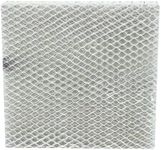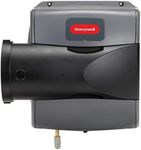Buying Guide for the Best Honeywell Furnace Humidifiers
Choosing the right Honeywell furnace humidifier for your home is essential to maintain a comfortable and healthy indoor environment. A humidifier adds moisture to the air, which can help alleviate dry skin, reduce static electricity, and prevent damage to wooden furniture and musical instruments. When selecting a humidifier, consider the size of your home, the type of humidifier, and the ease of maintenance. Here are some key specifications to help you make an informed decision.CapacityCapacity refers to the amount of moisture a humidifier can add to the air in a given time, usually measured in gallons per day. This spec is important because it determines how effectively the humidifier can maintain the desired humidity level in your home. For small to medium-sized homes, a humidifier with a capacity of 10-12 gallons per day may be sufficient. For larger homes, you may need a unit with a capacity of 15-18 gallons per day. Consider the size of your home and the level of dryness you experience to choose the right capacity.
Coverage AreaCoverage area indicates the maximum square footage a humidifier can effectively humidify. This is crucial to ensure that the humidifier can handle the size of your home or the specific area you want to humidify. Small units may cover up to 1,500 square feet, while larger units can cover up to 4,000 square feet or more. To pick the right one, measure the area you need to humidify and choose a model that can cover at least that much space.
Type of HumidifierThere are different types of furnace humidifiers, including bypass, fan-powered, and steam humidifiers. Bypass humidifiers use the furnace's blower to push air through a water panel, while fan-powered humidifiers have their own fan to circulate air. Steam humidifiers boil water to create steam, which is then distributed through the ducts. Bypass humidifiers are generally quieter and more energy-efficient, while fan-powered units are more effective for larger homes. Steam humidifiers provide the most consistent humidity levels but are more expensive and require more maintenance. Choose the type that best fits your home's needs and your preferences.
Ease of MaintenanceMaintenance involves tasks like cleaning the unit, replacing water panels or filters, and checking for any issues. This spec is important because regular maintenance ensures the humidifier operates efficiently and has a long lifespan. Some models have easy-to-access components and require less frequent maintenance, while others may need more regular attention. If you prefer a low-maintenance option, look for models with features like automatic cleaning or easy-to-replace parts.
Control OptionsControl options refer to how you can adjust and monitor the humidifier's settings. This can include manual controls, digital displays, and smart home compatibility. Having precise control over the humidity levels is important for maintaining comfort and preventing over-humidification. Basic models may have simple dial controls, while advanced models offer digital displays and can be integrated with smart home systems for remote control. Consider your comfort with technology and your desire for convenience when choosing control options.
Noise LevelNoise level is the amount of sound the humidifier produces during operation. This is important if the unit is located near living spaces or bedrooms where noise could be disruptive. Bypass humidifiers are typically quieter, while fan-powered and steam humidifiers may produce more noise. If noise is a concern, look for models that are specifically designed to operate quietly or have noise-reducing features.















